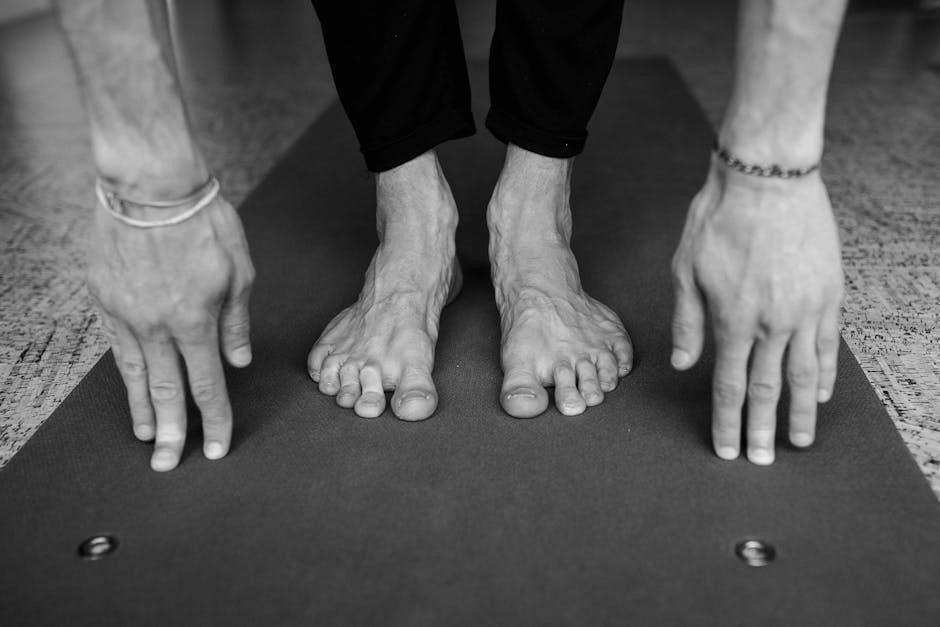Learning body parts in Spanish and English is essential for effective communication‚ especially in medical and educational contexts. This guide provides a comprehensive list of vocabulary‚ including external and internal organs‚ bones‚ and regional variations. Interactive PDF resources‚ such as worksheets and diagrams‚ are included to aid learners in mastering this fundamental topic;
Importance of Learning Body Parts Vocabulary
Understanding body parts in both Spanish and English is crucial for clear communication‚ especially in medical and educational settings. Knowing these terms helps describe injuries‚ illnesses‚ and basic anatomy. It also aids in completing exercises like matching games and drawing activities found in PDF resources. Learning this vocabulary enhances language proficiency and cultural understanding‚ making it easier to navigate real-life situations.Interactive PDFs‚ such as worksheets and diagrams‚ provide engaging tools to practice and master this essential vocabulary effectively.
Overview of the Article Structure
This guide is organized into clear sections to facilitate learning. It begins with an introduction to body parts in Spanish and English‚ followed by the importance of this vocabulary. The structure then progresses through basic external body parts‚ internal organs‚ regional variations‚ and visual aids like diagrams and PDF worksheets. Practical uses‚ such as describing injuries and medical terminology‚ are also covered. Adjectives for describing body parts and cultural tips enhance understanding. The article concludes with final thoughts and recommended resources‚ ensuring a comprehensive approach to mastering body parts vocabulary effectively.

Basic Vocabulary: External Body Parts
Learn essential external body parts in Spanish and English‚ such as cabeza (head)‚ brazo (arm)‚ mano (hand)‚ pierna (leg)‚ and pie (foot)‚ with clear translations and diagrams for easy understanding.
Head and Face Parts
Understanding head and face parts in Spanish is fundamental. Key terms include cabeza (head)‚ ojos (eyes)‚ nariz (nose)‚ boca (mouth)‚ orejas (ears)‚ and cabello (hair). These basic terms are essential for describing injuries or illnesses. For example‚ la frente (forehead) and las cejas (eyebrows) are also important. Learning these vocabulary words helps in everyday communication and medical contexts. Interactive PDFs and diagrams provide visual aids for better retention. Regional variations may exist‚ but these core terms remain consistent across most Spanish-speaking regions.
Upper Body Parts (Arms‚ Shoulders‚ Chest)
Learning upper body parts in Spanish is crucial for describing injuries or illnesses. Key terms include brazo (arm)‚ hombro (shoulder)‚ and pecho (chest). Additional terms like codo (elbow) and espaldas (back) are also essential. These terms are often used in medical contexts and daily conversations. Interactive PDFs and diagrams provide visual aids to help learners master these terms. Understanding regional variations ensures clarity across different Spanish-speaking regions. This vocabulary is foundational for building strong communication skills in both languages.
Lower Body Parts (Legs‚ Hips‚ Feet)
Mastering lower body parts in Spanish is vital for accurate communication. Key terms include pierna (leg)‚ cadera (hip)‚ and pie (foot). Additional terms like rodilla (knee) and tobillo (ankle) are also important. These terms are essential for describing injuries‚ such as knee scrapes or ankle sprains. Interactive PDFs and diagrams offer visual aids to enhance learning. Understanding these terms helps in both medical and everyday contexts‚ ensuring clear communication in Spanish-speaking environments. Regional variations are noted to provide a comprehensive understanding of the vocabulary.

Internal Body Parts and Organs
This section covers essential internal body parts in Spanish and English‚ such as el cerebro (brain)‚ el corazón (heart)‚ and el hígado (liver)‚ aiding in medical and anatomical discussions.
Major Organs and Their Functions
Understanding major organs in Spanish and English is crucial for medical communication. Key organs include el cerebro (brain)‚ controlling thoughts‚ and el corazón (heart)‚ pumping blood. El pulmón (lung) facilitates breathing‚ while el hígado (liver) detoxifies the body. El estómago (stomach) digests food‚ and el riñón (kidney) filters waste. El páncreas (pancreas) regulates blood sugar‚ and el intestino (intestine) absorbs nutrients. These terms are essential for describing health issues and bodily functions accurately in both languages‚ as detailed in PDF resources.
Bones and Skeletal System Vocabulary
Learning the bones and skeletal system in Spanish and English is vital for anatomical understanding. Key terms include huesos (bones) and esqueleto (skeleton). Major bones like el cráneo (skull)‚ la columna vertebral (spine)‚ la cadera (hip)‚ and la rodilla (knee) are essential. Other terms include la tibia (shinbone)‚ el fémur (thigh bone)‚ and el húmero (arm bone). PDF resources provide detailed diagrams and matching exercises to help learners master these terms‚ ensuring a strong foundation in skeletal anatomy for medical and educational purposes.

Regional Variations in Vocabulary
Spanish body part terms vary slightly between Latin American and European Spanish‚ with some regional differences in pronunciation and usage‚ though most remain consistent across dialects.
Differences in Latin American Spanish
In Latin American Spanish‚ some body part terms may vary slightly compared to European Spanish‚ though overall consistency remains high. For example‚ terms like antebrazo (forearm) and codo (elbow) are commonly used across regions. Additionally‚ regional dialects may influence pronunciation or preferred expressions. Interactive PDF resources and worksheets often highlight these variations‚ ensuring learners are exposed to diverse terminology. This adaptability helps learners communicate effectively across different Spanish-speaking regions‚ making the study of body parts in Spanish both practical and comprehensive for real-world applications.
European Spanish Variations
In European Spanish‚ body part terminology remains largely consistent‚ with terms like hombro (shoulder) and cadera (hip) being universally understood. The grammatical gender of nouns‚ such as el abdomen (abdomen) or la cadera‚ is clearly defined. Regional dialects in Spain may introduce slight variations in pronunciation but not in core vocabulary. PDF guides often include these terms‚ ensuring learners grasp the standard European Spanish usage. This consistency aids in clear communication‚ making European Spanish body part vocabulary reliable and accessible for learners of all levels.

Visual Aids for Learning
Interactive PDFs and body part diagrams in English and Spanish are excellent tools for visual learners. Labeled images and exercises help memorize vocabulary effectively‚ making lessons engaging.
Body Part Diagrams in English and Spanish
Body part diagrams in English and Spanish are invaluable for visual learners. These labeled illustrations provide a clear reference for identifying parts like la cabeza (head)‚ los ojos (eyes)‚ and el brazo (arm). Interactive PDFs often include matching exercises where students link English terms like “hair” to their Spanish equivalents‚ el pelo; Such tools simplify vocabulary memorization‚ making complex terms accessible and engaging for learners of all ages. Diagrams also highlight regional variations‚ ensuring a comprehensive understanding of body parts in both languages.
Interactive PDF Worksheets
Interactive PDF worksheets are an engaging way to learn body parts in Spanish and English. These resources often include matching exercises‚ where learners connect English terms like “ankle” with their Spanish counterparts‚ el tobillo. Many worksheets feature drawing activities‚ such as labeling diagrams of the human body in both languages. Some PDFs also include quizzes or word searches to reinforce vocabulary. Designed for all age groups‚ these interactive tools make learning fun and effective. They are particularly useful for visual learners and those who benefit from hands-on practice to memorize body part terminology bilingually.

Practical Uses of Body Parts Vocabulary
Mastering body parts vocabulary aids in medical communication‚ describing injuries‚ and understanding health conditions in both languages. It’s vital for accurate explanations during doctor visits or emergencies.
Describing Injuries or Illnesses
Knowing body parts vocabulary is crucial for describing injuries or illnesses accurately. It helps in explaining symptoms‚ such as a fractured pierna (leg) or a fever affecting the cabeza (head). Vocabulary lists in English and Spanish‚ like knee scrapes or broken arms‚ aid in clear communication during medical emergencies or doctor visits. Interactive PDF resources provide visual aids‚ such as diagrams‚ to identify body parts affected by injuries or illnesses‚ ensuring precise descriptions in both languages. This skill is essential for effective communication in healthcare settings‚ making it a vital part of language learning.
Medical Terminology Basics
Mastering body parts vocabulary in Spanish and English is foundational for understanding medical terminology. Terms like el corazón (heart) and las costillas (ribs) are essential for describing conditions such as cardiología (cardiology) or fracturas (fractures). Learning these terms enables learners to comprehend diagnoses and treatments accurately. Resources like PDF guides provide lists of organs and systems‚ aiding in the study of medical terms. This knowledge is vital for effective communication in healthcare settings‚ making it a key component of language acquisition for medical professionals and students.

Adjectives to Describe Body Parts
Adjectives like grande (big)‚ pequeño (small)‚ corto (short)‚ and largo (long) help describe body parts in Spanish and English‚ aiding in precise communication about size and shape.
Size and Shape Adjectives
Size and shape adjectives are essential for describing body parts accurately. Common adjectives include grande (big)‚ pequeño (small)‚ corto (short)‚ and largo (long). For example‚ un brazo largo (a long arm) or una nariz pequeña (a small nose). These adjectives help learners communicate effectively about physical characteristics. Interactive PDFs and worksheets often include exercises to practice these terms‚ making learning engaging and practical for students of all levels. Mastering these adjectives enhances descriptive skills in both Spanish and English.
Texture and Appearance Adjectives
Texture and appearance adjectives help describe the physical characteristics of body parts. Examples include suave (smooth)‚ rugoso (wrinkled)‚ delgado (slim)‚ and fortalecido (strong). For instance‚ una piel suave (smooth skin) or un cabello rizado (curly hair). These adjectives enhance descriptive accuracy‚ allowing learners to express details like skin texture or hair type. PDF resources often include exercises to practice these terms‚ making it easier to master descriptive language for body parts in both Spanish and English. This helps learners communicate more effectively about physical traits and appearances.

Cultural and Language Learning Tips
Mastering body parts in Spanish and English requires cultural insights and practical tips. Interactive PDFs offer regional variations and exercises to enhance learning. Focus on pronunciation and common phrases to build fluency and cultural understanding;
Common Phrases Using Body Parts
Learning common phrases with body parts is crucial for everyday communication. For example‚ “Me duele la cabeza” (My head hurts) or “¿Dónde está el baño?” (Where is the bathroom?). These phrases‚ often included in PDF resources‚ help learners describe injuries or illnesses. Interactive worksheets also provide exercises to match body parts with their Spanish and English names‚ enhancing vocabulary retention. Additionally‚ phrases like “Tengo una herida en la rodilla” (I have a wound on my knee) are essential for medical contexts. These practical phrases‚ paired with visual aids‚ make learning engaging and effective for all skill levels.
Memorization Techniques
Effective memorization of body parts in Spanish and English can be achieved through interactive activities. Matching games‚ where students pair Spanish terms with English equivalents‚ enhance retention. Flashcards with images and translations are also beneficial. Repetition exercises‚ such as writing and speaking the words‚ reinforce memory. Group study and role-playing activities encourage practical use of vocabulary. Using songs or rhymes with body part lyrics makes learning engaging. Visual aids‚ like labeled diagrams‚ help associate words with their meanings. Regular practice with PDF worksheets ensures long-term retention and mastery of the vocabulary.
This guide provides essential resources for learning body parts in Spanish and English‚ including interactive PDFs‚ diagrams‚ and vocabulary lists to support effective language acquisition and retention.
Final Thoughts on Learning Body Parts
Mastery of body parts vocabulary in Spanish and English is achievable through consistent practice and engaging resources like interactive PDFs and diagrams. Utilize flashcards‚ songs‚ and matching exercises to enhance retention. Regional variations and cultural nuances add depth to learning. Incorporate visual aids and practical exercises to make the process enjoyable and effective for learners of all ages. This foundational knowledge is crucial for communication in various contexts‚ from medical settings to everyday conversations.
Recommended PDF Resources
Enhance your learning with recommended PDF resources that offer interactive worksheets‚ body part diagrams‚ and vocabulary lists in both Spanish and English. These tools include matching exercises‚ regional variations‚ and visual aids to engage learners. Interactive PDFs like the Spanish Body Parts Worksheet help children and adults alike practice vocabulary through fun activities. Additionally‚ comprehensive guides provide detailed lists of internal organs‚ bones‚ and adjectives to describe body parts‚ ensuring a well-rounded understanding. Utilize these resources to make learning efficient and enjoyable for all skill levels.

